
Musical pillars of Indian temples
Have you ever heard of stone pillars that generates music? Yes that’s right. Such musical pillars are very common in temples of India. Such musical Pillars is the standing testimony of Indian art and architecture. If you have never witnessed the fantasy of Indian art and architecture, then this is one article that would give you a brief glimpse on highly dignified and talented works of Indian artists.
Renowned Architecture of Indian temples
Architectural genius of Indian temple is well known across the world. Intricately designed idols and wonderfully constructed sculptures adorned the beauty of the temple. Architectural design of wondrous sculptures and statues in every temple of India reflects the vibrant historical past of highly advanced Indian civilization. Modern engineers and artists are astonished to see the finite articulation of ancient architectural design and are often lost into thoughts on how this temples were built thousands of years ago when present scientific era do not have the instrument to design such architectural beauties. For Ex: A Single Madurai temple has thousands of statues carved from the single giant rock.
Musical pillars of India
Some of the major Indian temples that have musical pillars are
1.Vijaya vittal temple, Hampi.
Built by KrishnaDevaraya, this temple has around 56 musical pillars. When tapped gently, these pillars produce musical sounds. These pillars are popularly known as Musical Pillars or SaReGaMa pillars.
2.Nellaiappar Temple at Tirunelveli there are four musical pillars.
3.Thanumalayan Temple in Suchindrum in Tamil Nadu.
4.Adhinathar temple at Alwartirunagari in Tamil Nadu.
5.1000 pillars Madurai Meenakshi Temple
Hanging Pillar temple !
1.Dharmapuri, Mallikarjuneshwarar
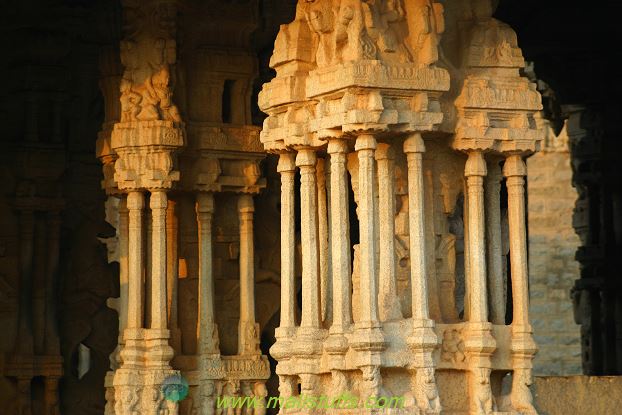
Types of musical pillars
There are two kinds of musical pillars
1) tapping pillars: music is produced by tapping pillar on fingers like we tap fingers on piano
2) Blowing pillars: music is produced by blowing into the holes as it is produced in case of conch
Musical temples of Vijayanagara kingdom
Vijayanagara kingdom made significant contribution in the construction of musical temples. More than five musical temples were constructed by Nayak Kings of Vijayanagara kingdom. Most famous of their 5+ musical temples is Sri Vittala Temple of Hampi. Architectural designs of Hampi have granted it a place in UNESCO world heritage site. When struck with a thumb, pillars of these temples produces a bell like sound. Research on flexural frequencies generated by this pillar found the sound to be very close to actual bell sound. Moreover, flexural frequencies were also found to satisfy Euler-Bernoulli beam model and energy separation algorithm (ESA) based on Teager’s energy operator.
https://www.youtube.com/watch?v=BT70gpN6uYU
SareGama Pillars of Sri Vijaya Vittala temple
Vittala temple is a magnificent piece of structural beauty and one of the best preserved ancient temples of India.

Water tank near the Vittala Temple
This massive complex with 56 musical pillars belongs to great Vijayanagara kingdom of the 13th century. Sculptors have enforced their musical skills into the statues. Sri Vijaya Vittala temple was has 56 musical pillars that produces Indian classical key notes ‘Sa,Re,Ga,Ma,PA,Dha,NEE’. These multi angled pillars are therefore known as SAREGAMA pillars. Some of the musical pillars produces bell like sound. Striking similarities have been found in the resonant sound waves produced by these musical pillars and any commonly found ringing bell. Frequency produced by musical pillars has been found to match with the flexural frequencies of Bernoulli beam model.
Perfectly carved stone pillars from a single huge rock reflects the talented skills and deep understanding of music, acoustics and sound physics. Each individual pillar is made up of many smaller and smaller pillars. These pillars are so beautifully carved with figures of musical instruments, musicians and dancers that even the renowned architects are mesmerized thinking about the highly advanced construction technology, tools and skills of ancient south-Indian laborers.
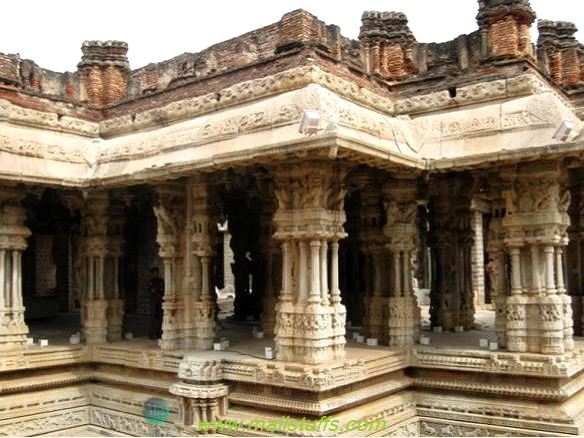
Pillars of vithal temple
Musical pillar of Nellaiappar Temple
In a small town of ‘Tiru Nelveli’ in Tamil Nadu, there is an ancient temple of lord shiva where elaborately designed stone pillars produces musical vibrations. Shiva, the lord of destruction and standing deity of this temple is called as lord Nellaiyappar by local devotees. Here, he is perceived as the protector of paddy crops and so, is the name given to this town, ‘nel’ meaning paddy and veli meaning ‘fence’ in Tamil. Tiru prefixed to nelveli means something special which may be the temple itself or the musical pillars of the temple. In this temple, Central pillar is surrounded by 48 small cylindrical pillars of varying girth. When the central pillar is tapped, vibrating sound is heard from the neighboring 48 pillars. Even the world renowned musicians and masters of musical instruments are not able to explain the construction of the pillars that resonates classical Indian sound waves.
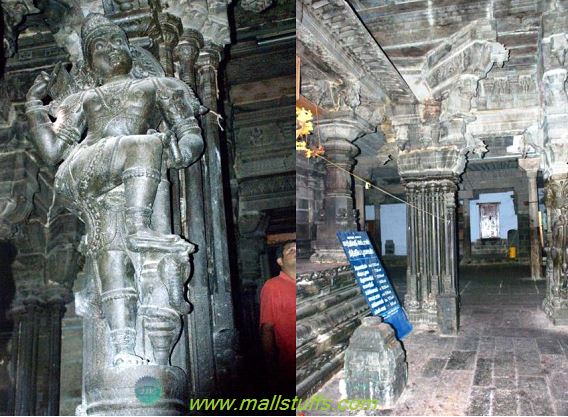
Some pillars were added and reconstructed by successive rulers but the 10 main musical pillars were left untouched. Spread over an area of 14 acres, musical pillars is also found in the shrine of “Goddess Gandhimathi” situated within the temple complex
Origin of this temple
According to documents kept at ‘Nelliyappar temple’, this temple with stone pillars was constructed in the 7th century by the Pandyan king ‘Nindraseer Nedumaran’ but archeologists refutes this claim and dates this temple back to the 4th century AD. This temple was built by the ancestors of the pandyan dynasty that ruled more or less whole of southern tamil nadu. ‘Tiru Nelveli’ was the capital of the flourishing Pandyan dynasty.
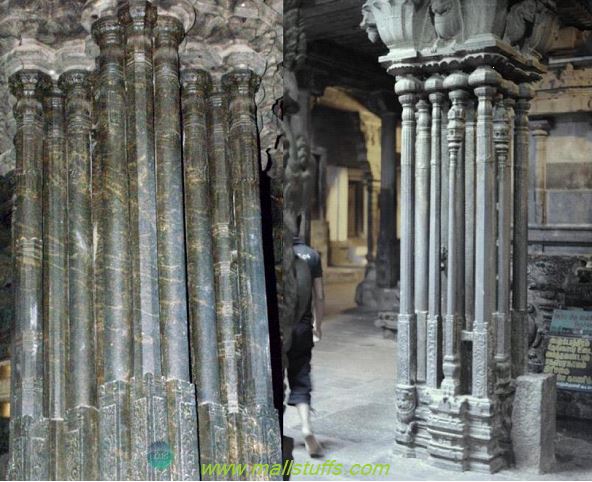
Musical Pillars of Nellaiappar Temple
Musical pillar of Thanumalayan Temple
Thanumalayan temple at Suchibram is also very similar to Nellaiappar temple. Just a gentle tap on the pillar produces the keynotes of Indian classical music.
In Tamil, Seven key notes of Indian music is known as saptha swarangal. Visitors and devotees are welcomed by the sound waves of saptha swarnagal emanating from the beautifully carved musical pillars. None of the visitors are able to understand the science of resonant waves emanating from these pillars. Northern side of the temple has two clusters of 24 pillars while southern side has a single cluster of 33 pillars. Each of these pillars are made from a single piece of rock and produces different kinds of sound on being tapped by different fingers of a hand.
<>
AUM sound of Shenbagarama Nallur
Sivan Koil of Shenbagarama Nallur near Nanguneri produces AUM sound on blowing the air into the holes similar to the blowing of conch or horn. Blowing air into the holes of rounded pillars produces "shangu or yeakalam like sound. Pillars are of same diameter, size and color. They are black or dark gray in color.
Musical pillar of Alwartiru Nagari temple
Granite stone of Alwartiru Nagari temple produces seven classical music notes. As it is detailed by Mr K K Pillai in his book
“The two northern groups present each a cluster of 24 pillars, while the southern ones present each a cluster of 33. A striking feature is that all the pillars of each group, together with the exquisitely carved turret at the top of each group are chiseled out of a single rock of granite. A tap on each of the pillars in a group produces different sound”.
Musical pillar of Shenpakanallur Perumal temple
Pillars are special, perfect and hollow with tubular holes at both sides. Located towards the South-West of Garba Graha, diameter of the pillar is uniform though one side seems to be slightly smaller than the other side. Various folds of the tubular pillar seem to be the reason behind the production of different sound.
Musical pillar of Suseeendrum temple
In this temple, there are 4 central pillars opposite to Bhairavar Mandapam surrounded by plenty of smaller pillars. Northern pillar is surrounded by 24 pillars whereas southern pillar is surrounded by 35 pillars. Each of these pillar is of square shape at the bottom and rectangular at the top. Sound Produced from these pillars is very similar to sound produced in Nellaiappar temple.
Musical pillar of Meenakshi Temple
Also a UNESCO heritage site, Meenakshi Temple is one of the architectural wonders of the world. Beautifully decorated damsels and dancers on temple walls can be found in other temples across the world but none of these temples have musical pillars that emanates soothing classical Indian music. Central monolith pillar of meenakshi temple is surrounded by 22 more mini-musical pillars.
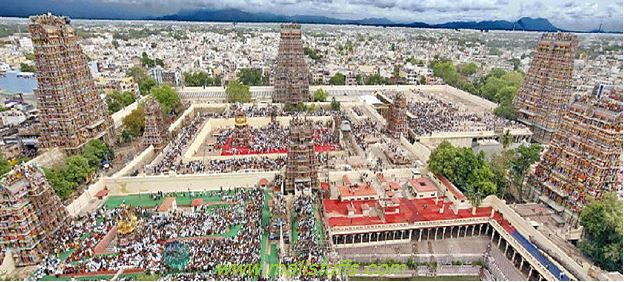
Meenakshi temple complex
<>
Other musical temples
Some of the lesser known temples with musical pillars are as follows
1.Alakarkovil,
2.Alvarthirunagari
3.Kalakadu
4.Kuttralam
5.Suseendrum
6.Senpaghanalur
7.Tadpatri.
8.Thadikombu
9.Tirupati
10.Thiruvananthapuram
11.Tirunelveli
12.Tenkasi
13.Banglore ramarajanpeattai
14.Lepakshi
15.Hampi0
Modern architects failed in creating such elaborate musical pillars
To construct such pillars, many architects have been doing extensive research like taking accurate measurement of pillars using meter tape, recording of sound and identifying crucial point of the pillars. Musical pillars of ‘suchidram’ were studied using a high fidelity tape recorder, measuring tape and wooden plant. Researchers physically measured the height, width, circumference and other features of the temples. They also analyzed and identified modal points of the temple.
But as of now, none of them have been successful in creating laborious pillars on such a gigantic scale.
Musical performance in these temples
Many group musical performances has been performed in these temples by band of musicians hitting pillars with their musical stick to generate the rhythmic sound. Performers stood on two opposite sides of the pillars to play group music. Music performances were accompanied by classical dance performers. Tone vibrations emerging from the pillars were very similar to the tone of ‘Thala Alangaram’.
Ancient Indians produced 'rock music'
Recently, Indian archeologists have found an ancient rock site in south India with large boulders capable of producing ritual sounds that can be heard by the whole city. Beautifully carved rocks with unusual structures and groove like depressions were designed to be struck powerfully by a large hammer to produce tumultuous musical sound. Locals call these special rocks as musical rock. When hit with a granite song, this rock produces a gong-like echoing sound
Summary:
Musical temples of India reflect the highly advanced technology and talented skills of Indian artists. Such musical Pillars is the perfect demonstration of sophisticated Indian art and architecture. Sadly, lack of government efforts in preservation and advertisement of these musical temples have kept it hidden from large section of the world population.
Note: Images used on this website
are either a production of Bhaktivedanta Book Trust(https://www.krishna.com), Iskcon
Foundation or were found in google search under "Free to use and share". If any
of the images presented here violates copyright issues or infringes anyone copyright
or are not under "Fair use", then please bring it to our notice. Read
Disclaimer for more.
Share this to your friends. One of your friend is
waiting for your share.
Related Articles
How chanting AUM or mantras heals diseases
Why Idol worship in hinduism
Musical pillars of Indian temples
Post Comment